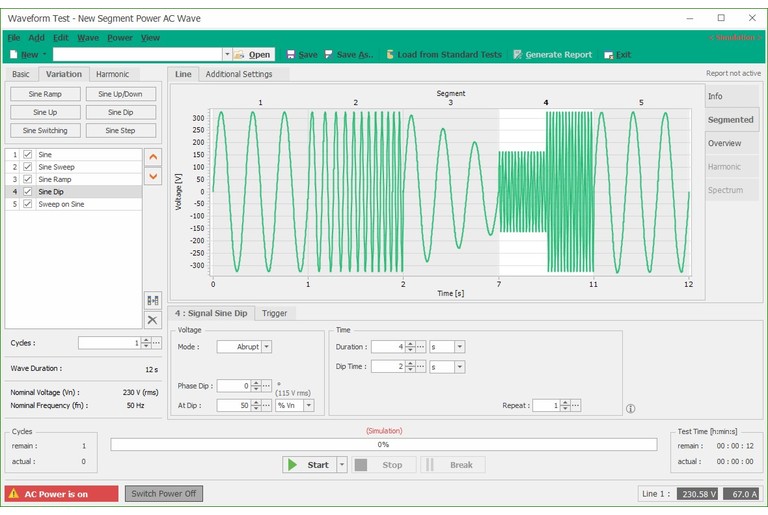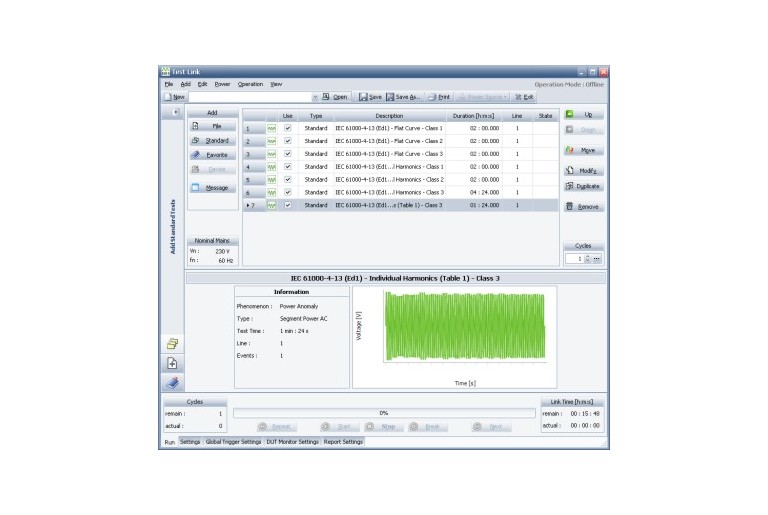|
|
SOFTWARE:net.control
SOFTWARE FOR TESTING AC/DC SUPPLY ANOMALIES AS PER EN/IEC STANDARDS AND MIL/DO REQUIREMENTS AND HARMONIC & FLICKER
-
net.control - The highlights
-
The standards' update
-
Standard voltage profiles pre-programmed
-
Easy to do - numerous standard segments for programed user defined profiles
-
Flowchart - Your graphic tool to create test routines
-
TestLink - Composing complete test routines based on single waves
-
Import and export of profiles
-
Documentation and test reports
net.control - The highlights
net.control is THE software tool specifically developed to cope with today's more and more expanding requirements for AC/DC supply simulation in the industrial area including aircraft and military test requirements. Creation of any kind of waveforms and profiles is as easy as can be. Complex test procedures can be composed in a flow chart considering the operators intervention based on the test results achieved on a partial test.
But net. control is not only designed to generate waveforms. With the net. control you can also measure and analyze arbitrary processes such as harmonics and flicker.
The current version net.control 2.1.5 offers:
-
Windows 7, Windows 8 (64Bit) and Windows 10 compatibility
-
Support of Ethernet and GPIB interfaces
-
Enhanced library with the actual IEC/EN standards
-
Extended library for DO-160 and Airbus test requirements, including several hundred pre-programmed test sequences!
-
Enhanced and highly flexible reporting capabilites
-
Up-to-date design and navigation
-
Intuitive operation
|
The standards' update
The following standards are supported by the 2.1.x release:
-
IEC 61000-3-2 (Edition 5, 2018-1)
-
IEC 61000-8-3 (Edition 3, 2017-02)
-
IEC 61851-21-1 (Edition 1, 2017-06)
-
Hyundai Kia ES96200-00 (Revision O, 2016-03)
-
Hyundai Kia ES96200-00 (Revision L, 2014-03)
-
Mercedes-Benz MBN 10284-3 (2015-07)
-
Nissan 28400NDS91 (2012-03)
-
Renault 36-00-811 (2014-12)
-
Volkswagen VW 80300 (2016-10)
-
MIL-STD-704F (HDC101 Test D)
New Devices and Equipment implemented in the 2.1.x release:
-
AMP 200N2
-
SNG 200P
-
NetWave 30.4
The following standards are supported by the 2.0.x release: Last release V2.0.4
-
BMW GS95002-3 (2015-12)
-
BMW GS95023 (2016-11)
-
EN 12015 (2014-07)
-
GB 17625.1 (2012-12)
-
GB 17625.2 (2007-05)
-
IEC 61000-3-2 (Edition 3.2, 2009-08)
-
IEC FDIS 61000-3-2 (Edition 5, 2017-11)
-
IEC 61000-3-3 (Edition 3, Amendment 1, 2017-05)
-
IEC 61000-3-11 (Edition 2, 2017-04)
-
IEC 61000-6-5 (Edition 1, 2015-08)
-
IEC 61000-6-7 (Edition 1, 2014-10)
-
IEC 61850-3 (Edition 2, 2013-12) ISO TS 7637-4 (2017-03) - 4.4.6 Low frequency sinusoidal disturbances (Pulse C)
-
MIL-STD-704F (Change 1, 2016-12)
-
PSA B21 7112 (2015-09)
-
SAE J2894/2 (2015-03)
New Devices and Equipment implemented in the 2.0.x release:
-
NetWave 3.1
-
NetWave 20.3
-
NetWave 30.3
-
NetWave 60.3
-
NetWave 67
-
NetWave 67.2
-
NetWave 67.3
-
NetWave 90.3
-
NetWave 108.3
-
CN 200N100 (One Transformer, 100 A, 1200 Vdc)
-
CN 200N200 (2 Transformer, 200 A, 1200 Vdc)
-
CN 200N300 (3 Transformer, 300 A, 1200 Vdc)GB 17625.2 (2007-05)
The following standards are supported by the 1.2.x release: Last release V1.2.10
-
EN/IEC 61000-3-2
-
EN/IEC 61000-3-3
-
EN/IEC 61000-3-11
-
EN/IEC 61000-3-12
-
EN/IEC 61000-4-13
-
EN/IEC 61000-4-14
-
EN/IEC 61000-4-17
-
EN/IEC 61000-4-27 (pre-compliance, 3-phase series only)
-
EN/IEC 61000-4-28
-
EN/IEC 61000-4-29
-
EN/IEC 61000-4-11 (pre-compliance)
-
IEC 61800-3 (Edition 2.1, 2012-03)
-
EN 12016 (2013-12)
-
EN 55103-2 (2009-07)
-
ETSI EN 300 132-2 (Version 2.4.6, 2011-12)
-
GJB181A (2003)
-
GJB181 (1996)
-
JIS W0812 (2004)
-
avionic testing requirements such as
-
DO-160D (1997-07)
-
DO-160E (2004-12)
-
DO-160F (2007-06)
-
DO160F/G, ED-14G (Chapter 16)
-
DO160E/F/G, ED14G (Chapter 18)(1&3 ph)
-
Airbus ABD0100.1.8 (Rev. E, 2005-04)
-
Airbus ABD0100.1.8.1 (Rev. C, 2008-08)
-
Airbus AMD24 (Rev. C, 2005-03)
-
Boeing
-
as well as military test applications (MIL-STD-461F, MIL-STD 704, MIL-STD-1275E )
New Devices and Equipment implemented in the 1.0.x release:
-
All Netwave models
-
DPA 500x
-
DPA 503x
-
AIF503
-
ACS 500N3
-
ACS 500N6
-
ACS 500N16
-
ACS 500N30
-
ACS 500N60
-
ACS 500N90
-
ACS 500
-
ACS 503
-
External Source
|
Standard voltage profiles pre-programmed

Mains supply simulation is becoming more and more dominant in todays' testing. A variety of test requirements are set out to ensure troublefree operation of any kinds of electronics in today's highly disturbed and noisy mains supply systems. Supply anomalies like harmonics, voltage variation, frequency variation, voltage unbalance are found in these test requirements.
EM TEST has set-up a library of standards including all test requirements from the relevant standards to be available by only a few mouse clicks.
New requirements are constantly implemented updating the standards library to cope with the growing demands from the market.
|
|
Easy to do - numerous standard segments for programed user defined profiles
 What ever special profile you will need to test net.control makes your work as easy as possible. The segment mode is split into two sections: the AC Power mode and the DC Power mode.
In the AC Power mode you can chose from a large number of different segment types such as sine wave, sine wave sweep, sine wave up/down, modulation, dip, overswing, sweep on sine, harmonic, harmonic distortion, interharmonic and interharmonic step.
In the DC Power mode segments types such as DC, ramp, square, triangle, sine wave, sine wave sweep, sine ripple, exponent wave etc. are available to program your induvidual profiles and adjust each single parameter as required for your test.
Everything's already there. What ever special profile you will need to test net.control makes your work as easy as possible. The segment mode is split into two sections: the AC Power mode and the DC Power mode.
In the AC Power mode you can chose from a large number of different segment types such as sine wave, sine wave sweep, sine wave up/down, modulation, dip, overswing, sweep on sine, harmonic, harmonic distortion, interharmonic and interharmonic step.
In the DC Power mode segments types such as DC, ramp, square, triangle, sine wave, sine wave sweep, sine ripple, exponent wave etc. are available to program your induvidual profiles and adjust each single parameter as required for your test.
Everything's already there.
Flowchart - Your graphic tool to create test routines

The flowchart tool allows the user to create his own test sequences with more than one test wave.
The flowchart tool is a very unique highlight of net.control. No other software offers such a tool. However, it is exactly what is needed to create automated tests such as those required e.g. as per EN/IEC 61000-4-13. Based on the class related to the DUT a number of tests need to be applied subject to the test result achieved in the previous test. The relevant flowchart is given by the standard and is directly implemented into the net.control software to allow best user convenience. Based on the result achieved the operator simply continues the test by a simple mouse click. Full documentation of such a test is stored and and transferred into the test report.
The user can create his own flowcharts based on individual test requirements or change an existing flowchart as per his needs. Operation is very simple and intuitive, still very flexible.
|
TestLink - Composing complete test routines based on single waves
 TestLink is the mode to create complete test routines or sequences based on different test waves. These test waves can be standard test waves, individual test waves created by the user, waves loaded from the library or device files imported to the software. TestLink is the mode to create complete test routines or sequences based on different test waves. These test waves can be standard test waves, individual test waves created by the user, waves loaded from the library or device files imported to the software.
By means of the LinkTest mode test sequences consisting of up to 999 test waves can be created. This goes far beyond "normal" testing and covers even most complex test requirements. Moreover, the user can insert breaks to display messages created by the net.control software or to enter any comment being implement in the test report.
The LinkTest mode also offers the ability to define global trigger functions superseeding any individual settings made for the single test waves used in the LinkTest file.
Import and export of profiles

|
net.control cannot only be used to program wave forms and profiles. It can also import data in various formats like CSV, Excel, XML etc.) and manage such profiles.
|
Documentation and test reports
 Nowadays each and every test needs to be well documented for reasons of reproducibility and proof of testing. net.control offers an enhanced reporting capability that fulfills every aspect of common QM systems what test documentation is concerned. The test data (both generated and recorded data) is properly referenced and stored in a data base. The report can be exported in different formats like RTF, PDF or HTML etc. User defined forms can be used as a mask file to include the report data. Nowadays each and every test needs to be well documented for reasons of reproducibility and proof of testing. net.control offers an enhanced reporting capability that fulfills every aspect of common QM systems what test documentation is concerned. The test data (both generated and recorded data) is properly referenced and stored in a data base. The report can be exported in different formats like RTF, PDF or HTML etc. User defined forms can be used as a mask file to include the report data.
|

 What ever special profile you will need to test net.control makes your work as easy as possible. The segment mode is split into two sections: the AC Power mode and the DC Power mode.
What ever special profile you will need to test net.control makes your work as easy as possible. The segment mode is split into two sections: the AC Power mode and the DC Power mode.
 TestLink is the mode to create complete test routines or sequences based on different test waves. These test waves can be standard test waves, individual test waves created by the user, waves loaded from the library or device files imported to the software.
TestLink is the mode to create complete test routines or sequences based on different test waves. These test waves can be standard test waves, individual test waves created by the user, waves loaded from the library or device files imported to the software.

 Nowadays each and every test needs to be well documented for reasons of reproducibility and proof of testing. net.control offers an enhanced reporting capability that fulfills every aspect of common QM systems what test documentation is concerned. The test data (both generated and recorded data) is properly referenced and stored in a data base. The report can be exported in different formats like RTF, PDF or HTML etc. User defined forms can be used as a mask file to include the report data.
Nowadays each and every test needs to be well documented for reasons of reproducibility and proof of testing. net.control offers an enhanced reporting capability that fulfills every aspect of common QM systems what test documentation is concerned. The test data (both generated and recorded data) is properly referenced and stored in a data base. The report can be exported in different formats like RTF, PDF or HTML etc. User defined forms can be used as a mask file to include the report data. 

